Magnetic Properties of SmCo5 + 10 wt% Fe Exchange-Coupled Nanocomposites Produced from Recycled SmCo5
Abstract
1. Introduction
2. Materials and Methods
3. Results and Discussions
4. Conclusions
Supplementary Materials
Author Contributions
Funding
Acknowledgments
Conflicts of Interest
References
- Sander, D.; Valenzuela, S.O.; Makarov, D.; Marrows, C.H.; Fullerton, E.E.; Fischer, P.; McCord, J.; Vavassori, P.; Mangin, S.; Pirro, P.; et al. The 2017 Magnetism Roadmap. J. Phys. D. Appl. Phys. 2017, 50. [Google Scholar] [CrossRef]
- Coey, J.M.D. Hard Magnetic Materials: A Perspective. IEEE Trans. Magn. 2011, 47, 4671–4681. [Google Scholar] [CrossRef]
- Goll, D.; Kronmüller, H. High-performance permanent magnets. Naturwissenschaften 2000, 87, 423–438. [Google Scholar] [CrossRef]
- Coey, J.M.D. Perspective and Prospects for Rare Earth Permanent Magnets. Engineering 2020, 6, 119–131. [Google Scholar] [CrossRef]
- Nassar, N.T.; Du, X.; Graedel, T.E. Criticality of the Rare Earth Elements. J. Ind. Ecol. 2015, 19, 1044–1054. [Google Scholar] [CrossRef]
- Binnemans, K.; Jones, P.T.; Blanpain, B.; Van Gerven, T.; Yang, Y.; Walton, A.; Buchert, M. Recycling of rare earths: A critical review. J. Clean. Prod. 2013, 51, 1–22. [Google Scholar] [CrossRef]
- Liu, J.P. Exchange-coupled nanocomposite permanent magnets. In Nanoscale Magnetic Materials and Applications; Ping Liu, J., Fullerton, E.E., Gutfleisch, O., Sellmyer, D.J., Eds.; Springer US: Boston, MA, USA, 2009; pp. 309–335. ISBN 9780387855981. [Google Scholar]
- Kneller, E.F.; Hawig, R. The exchange-spring magnet: A new material principle for permanent magnets. IEEE Trans. Magn. 1991, 27, 3560–3588. [Google Scholar] [CrossRef]
- Skomski, R.; Coey, J.M.D. Exchange coupling and energy product in random two-phase aligned magnets. IEEE Trans. Magn. 1994, 30, 607–609. [Google Scholar] [CrossRef]
- Balamurugan, B.; Sellmyer, D.J.; Hadjipanayis, G.C.; Skomski, R. Prospects for nanoparticle-based permanent magnets. Scr. Mater. 2012, 67, 542–547. [Google Scholar] [CrossRef]
- Jiang, J.S.; Bader, S.D. Rational design of the exchange-spring permanent magnet. J. Phys. Condens. Matter 2014, 26, 64214. [Google Scholar] [CrossRef] [PubMed]
- Schrefl, T.; Fidler, J.; Kronmüller, H. Remanence and coercivity in isotropic nanocrystalline permanent magnets. Phys. Rev. B 1994, 49, 6100–6110. [Google Scholar] [CrossRef] [PubMed]
- Fischer, R.; Schrefl, T.; Kronmüller, H.; Fidler, J. Grain-size dependence of remanence and coercive field of isotropic nanocrystalline composite permanent magnets. J. Magn. Magn. Mater. 1996, 153, 35–49. [Google Scholar] [CrossRef]
- Li, H.; Wu, Q.; Yue, M.; Cong, L.; ZhuGe, Y.; Wang, D.; Li, Y.; Zhang, J. A novel strategy for approaching high performance SmCo5/Co nanocomposites. J. Alloys Compd. 2019, 810, 151890. [Google Scholar] [CrossRef]
- Majetich, S.A.; Chowdary, K.M.; Kirkpatrick, E.M. Size and interaction effects in the magnetization reversal in SmCo5 nanoparticles. IEEE Trans. Magn. 1998, 34, 985–987. [Google Scholar] [CrossRef]
- Pop, V.; Isnard, O.; Chicinaş, I.; Givord, D. Magnetic and structural properties of SmCo5/α-Fe nanocomposites. J. Magn. Magn. Mater. 2007, 310, 2489–2490. [Google Scholar] [CrossRef]
- Hirian, R.; Isnard, O.; Pop, V. Structural and magnetic properties of SmCo5 + 30% α-Fe exchange coupled nanocomposites obtained by mechanical milling. J. Optoelectron. Adv. Mater. 2019, 21, 618–622. [Google Scholar]
- Lardé, R.; Le Breton, J.M.; Maiître, A.; Ledue, D.; Isnard, O.; Pop, V.; Chicinaş, I. Atomic-scale investigation of SmCo5/α-Fe nanocomposites: Influence of Fe/Co interdiffusion on the magnetic properties. J. Phys. Chem. C 2013, 117, 7801–7810. [Google Scholar] [CrossRef]
- Ito, M.; Majima, K.; Umemoto, T.; Katsuyama, S.; Nagai, H. Magnetic properties and microstructure of SmCo5 + α-Fe nanocomposite magnets prepared by mechanical alloying. J. Alloys Compd. 2001, 329, 272–277. [Google Scholar] [CrossRef]
- Zhang, J.; Zhang, S.Y.; Zhang, H.W.; Shen, B.G. Structure, magnetic properties, and coercivity mechanism of nanocomposite SmCo5/α-Fe magnets prepared by mechanical milling. J. Appl. Phys. 2001, 89, 5601–5605. [Google Scholar] [CrossRef]
- Eldosouky, A.; Škulj, I. Hydrogen Reaction with SmCo Compounds: Literature Review. J. Sustain. Metall. 2018, 4, 516–527. [Google Scholar] [CrossRef]
- Khazdozian, H.A.; Manzano, J.S.; Gandha, K.; Slowing, I.I.; Nlebedim, I.C. Recycled Sm-Co bonded magnet filaments for 3D printing of magnets. AIP Adv. 2018. [Google Scholar] [CrossRef]
- Eldosouky, A.; Ikram, A.; Mehmood, M.F.; Xu, X.; Sturm, S.; Zuzek Rozman, K.; Skulj, I. Hydrogen Decrepitation and Spark Plasma Sintering to Produce Recycled SmCo5 Magnets with High Coercivity. IEEE Magn. Lett. 2018, 9, 5–9. [Google Scholar] [CrossRef]
- Sepehri-Amin, H.; Dirba, I.; Tang, X.; Ohkubo, T.; Schrefl, T.; Gutfleisch, O.; Hono, K. Development of high coercivity anisotropic Nd-Fe-B/Fe nanocomposite powder using hydrogenation disproportionation desorption recombination process. Acta Mater. 2019, 175, 276–285. [Google Scholar] [CrossRef]
- Yang, J.; Han, J.; Tian, H.; Zha, L.; Zhang, X.; Song Kim, C.; Liang, D.; Yang, W.; Liu, S.; Wang, C. Structural and Magnetic Properties of Nanocomposite Nd–Fe–B Prepared by Rapid Thermal Processing. Engineering 2020, 6, 132–140. [Google Scholar] [CrossRef]
- Fan, J.; Yao, L.; Wang, F.; Shen, W.; Yi, J.; Liu, Y.; Liu, J.P. Effect of Co-substituted soft-phase precursors on structural and magnetic properties of Nd2Fe14B/Fe(Co) nanocomposite materials. Mater. Res. Express. 2019, 6, 75021. [Google Scholar] [CrossRef]
- Pan, M.; Li, Z.; Wu, Q.; Ge, H.; Xu, H. Study of the role of Ti doping on magnetic properties of some nanocomposite alloys of α-Fe/Nd2Fe14B type. J. Magn. Magn. Mater. 2019, 471, 457–463. [Google Scholar] [CrossRef]
- Ryo, H.S.; Kim, K.G.; Kim, Y.J. An analytic study on coercivity mechanism of exchange coupled Nd2Fe14B/α-Fe nanocomposite magnets. J. Magn. Magn. Mater. 2019, 469, 531–534. [Google Scholar] [CrossRef]
- Eldosouky, A.; Škulj, I. Recycling of SmCo5 magnets by HD process. J. Magn. Magn. Mater. 2018, 454, 249–253. [Google Scholar] [CrossRef]
- Dorolti, E.; Trifu, A.V.; Isnard, O.; Chicinaş, I.; Tolea, F.; Valeanu, M.; Pop, V. Influence of mechanical milling on the physical properties of SmCo5/Fe65Co35 type hard/soft magnetic nanocomposite. J. Alloys Compd. 2013, 560, 189–194. [Google Scholar] [CrossRef]
- Rong, C.B.; Zhang, Y.; Kramer, M.J.; Liu, J.P. Correlation between microstructure and first-order magnetization reversal in the SmCo5/α-Fe nanocomposite magnets. Phys. Lett. Sect. A Gen. At. Solid State Phys. 2011, 375, 1329–1332. [Google Scholar] [CrossRef]
- Leslie-Pelecky, D.L.; Schalek, R.L. Effect of disorder on the magnetic properties of SmCo5. Phys. Rev. B 1999, 59, 457–462. [Google Scholar] [CrossRef]
- Cullity, B.D.; Stock, S.R. Diffraction III: Real Samples. In Elements of X-ray Diffraction; Pearson Education Limited: Harlow, UK, 2014; pp. 171–187. ISBN 978-1-292-04054-7. [Google Scholar]
- Morrish, A.H. The Physical Principles of Magnetism, Classic Reissue; IEEE Press: New York, NY, USA, 2001; p. 394. ISBN 9780470546581. [Google Scholar]
- Bogatin, Y.G.; Povolotskii, E.G. Effect of heat treatment on phase and structural transformation in SmCo5 alloy powder. Sov. Powder Metall. Met. Ceram. 1980, 19, 494–497. [Google Scholar] [CrossRef]
- Schneider, G.; Henig, E.T.; Lukas, H.L.; Petzow, G. Phase relations in the samarium-poor Sm-Co-Fe system. J. Less-Common Met. 1985, 110, 159–170. [Google Scholar] [CrossRef]
- Hirian, R.; Neamţu, B.V.; Ferenczi, A.; Isnard, O.; Chicinaş, I.; Pop, V. Effect of spark plasma sintering on the interphase exchange coupling in SmCo5 + 20% Fe hard/soft nanocomposites. Rom. J. Phys. 2020, 65, 603. [Google Scholar]
- Hirian, R.; Bolinger, A.; Isnard, O.; Pop, V. Influence of high anisotropy phase on the properties of hard–soft magnetic nanocomposite powders obtained by mechanical milling. Powder Metall. 2018, 61, 369–373. [Google Scholar] [CrossRef]
- Chen, L.C.; Spaepen, F. Analysis of calorimetric measurements of grain growth. J. Appl. Phys. 1991, 69, 679–688. [Google Scholar] [CrossRef]
- Tanaka, T. Comminution Laws. Several Probabilities. Ind. Eng. Chem. Process Des. Dev. 1966, 5, 353–358. [Google Scholar] [CrossRef]
- Zhang, Y.; Kramer, M.J.; Rong, C.; Liu, J.P. Microstructure and intergranular diffusion in exchange-coupled Sm–Co/Fe nanocomposites. Appl. Phys. Lett. 2010, 97, 32506. [Google Scholar] [CrossRef]
- Liu, X.B.; Altounian, Z. The mixing of Fe/Co and its effect on the exchange interaction in SmCo5/α-Fe nanocomposites: A first-principles study. J. Appl. Phys. 2012, 111, 2010–2013. [Google Scholar] [CrossRef]
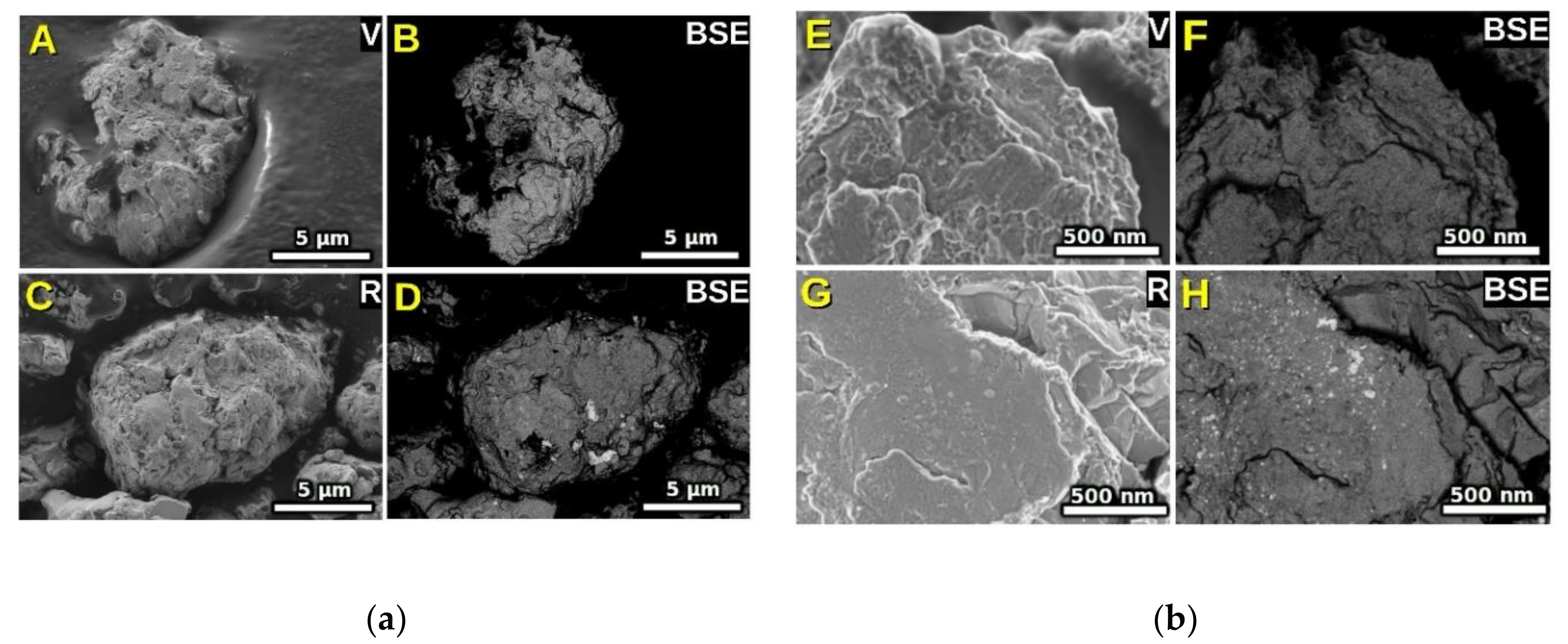
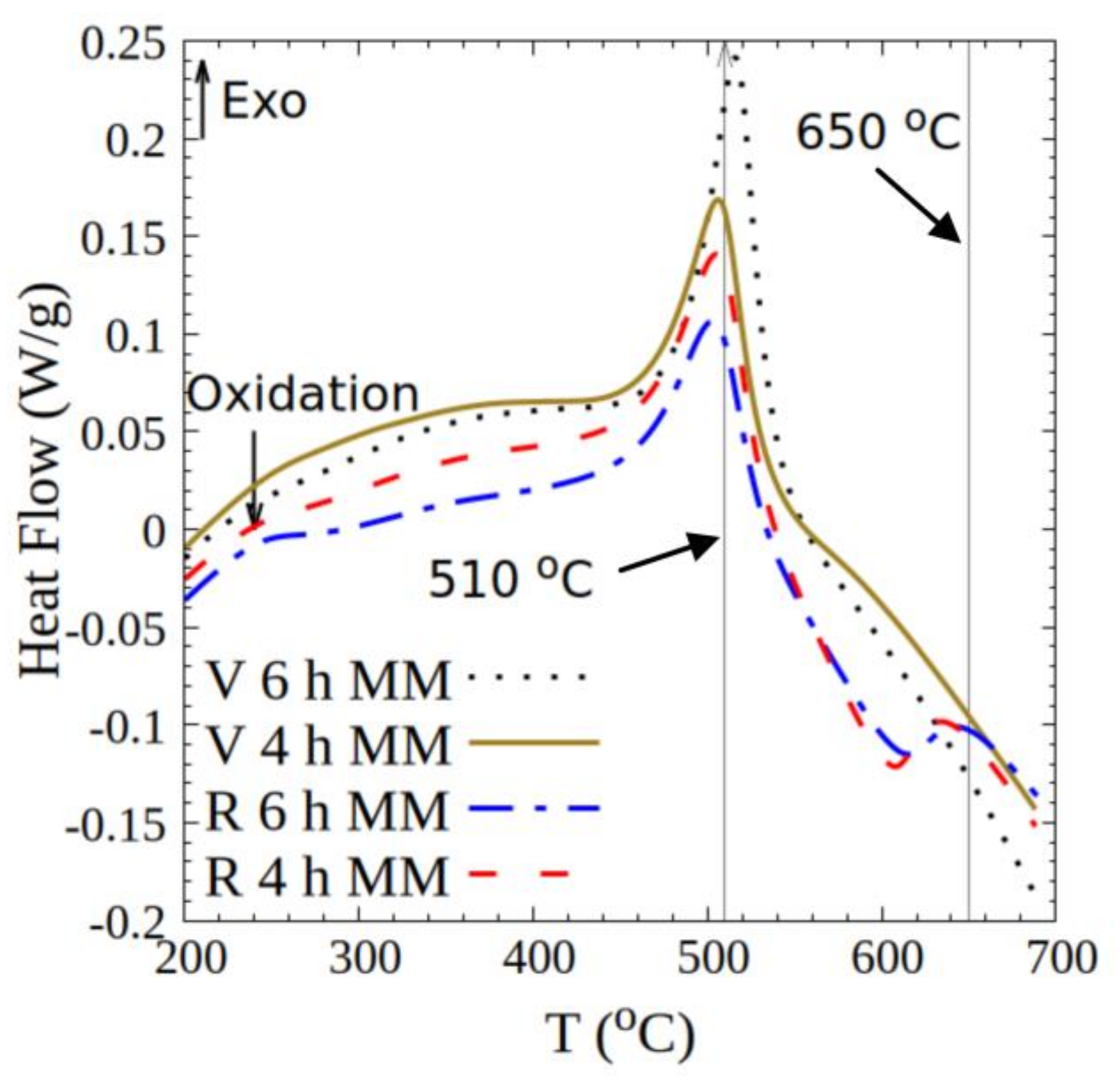
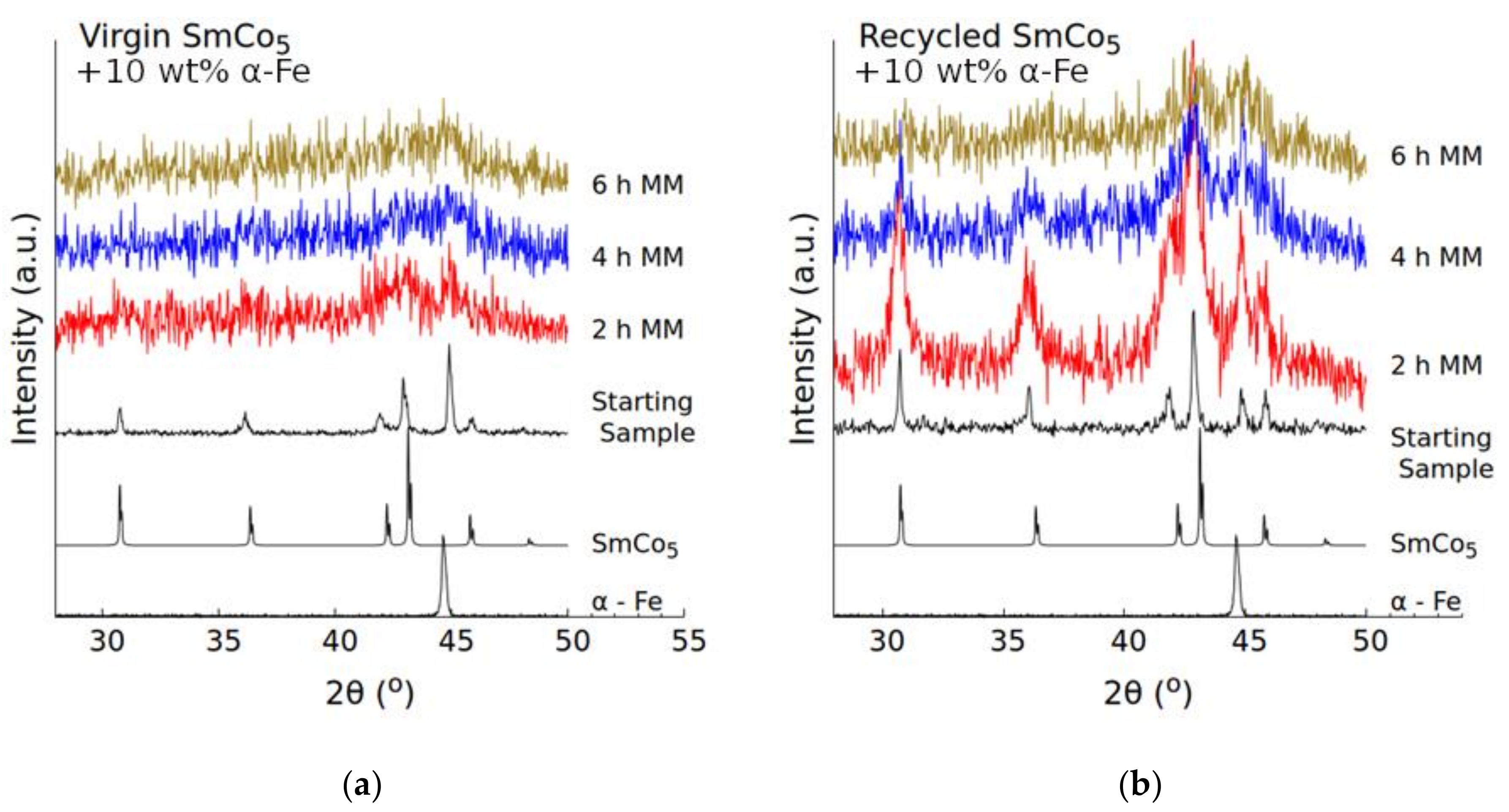


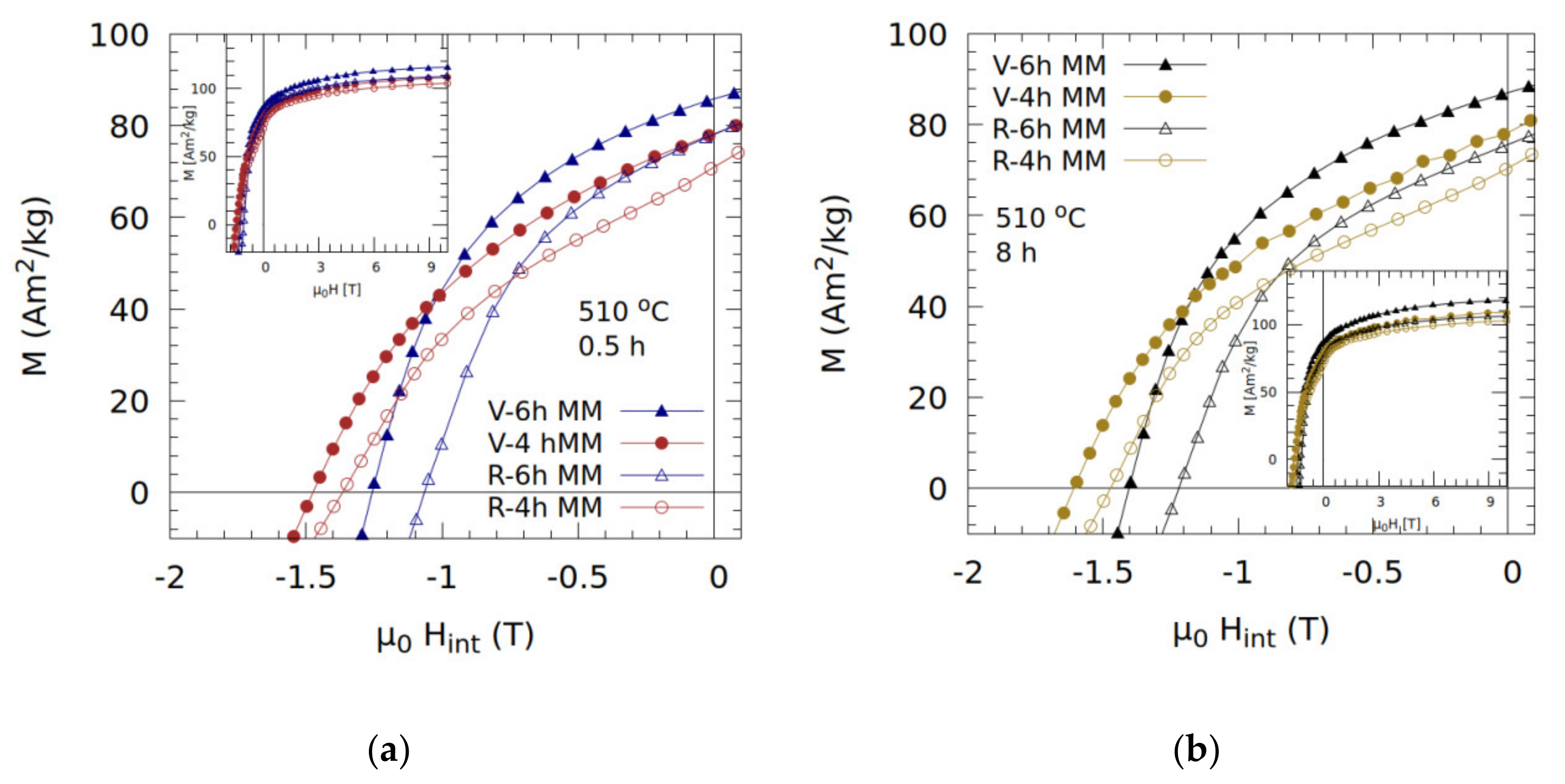
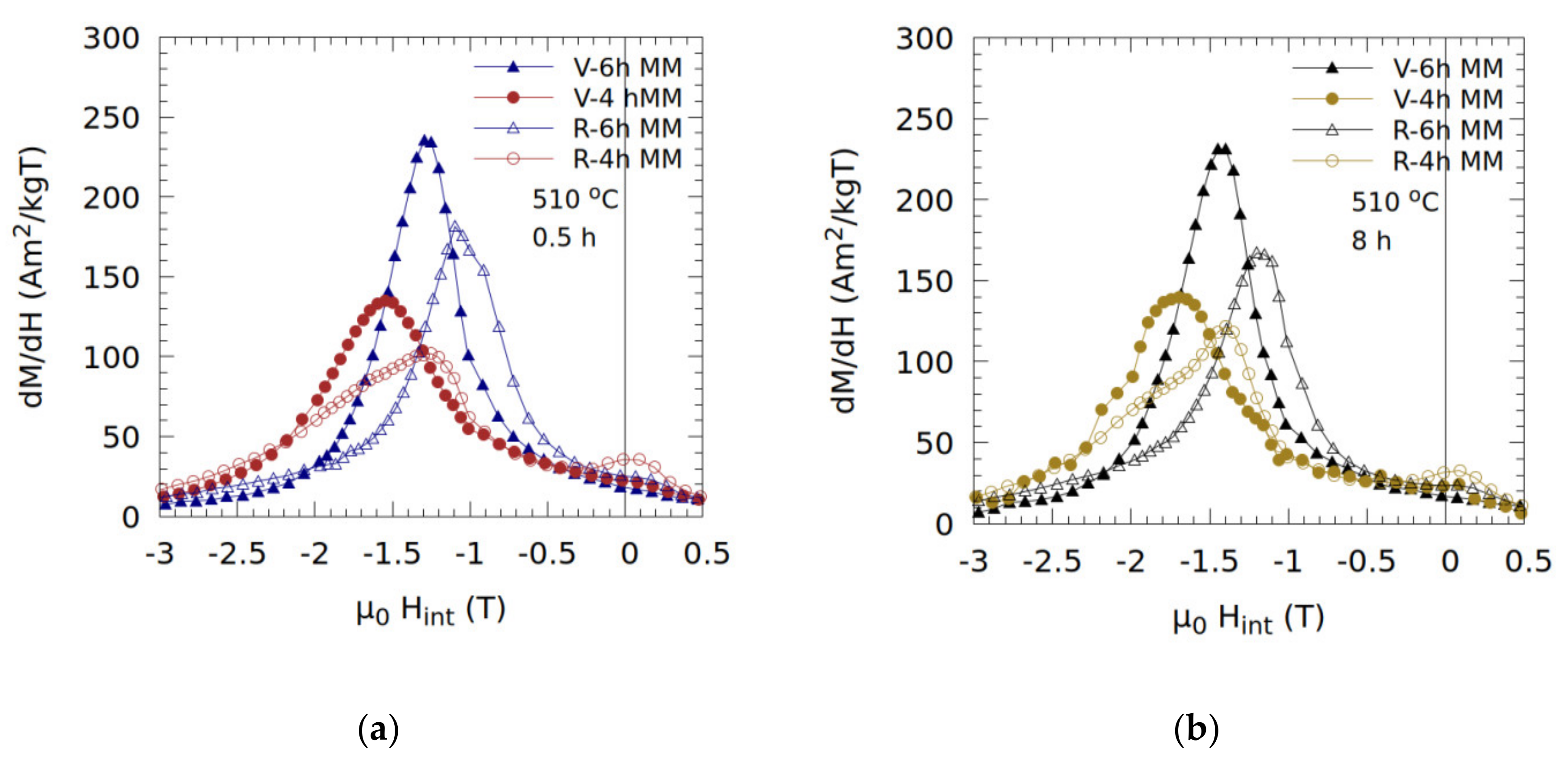
| Material | Milling Duration | Heat Treatment | FWHM | FWHM Error | Crystallite Size | Size Error | |
|---|---|---|---|---|---|---|---|
| Temp. | Duration | (deg) | (deg) | (nm) | (nm) | ||
| Virgin SmCo5 + 10 wt% Fe | 6 h | 600 °C | 0.5 h | 0.7 | 0.1 | 13 | 1 |
| 510 °C | 8 h | 0.7 | 0.2 | 12 | 5 | ||
| 0.5 h | 0.8 | 0.2 | 10 | 3 | |||
| 4 h | 600 °C | 0.5 h | 0.6 | 0.1 | 14 | 2 | |
| 510 °C | 8 h | 0.8 | 0.1 | 11 | 2 | ||
| 0.5 h | 1.1 | 0.2 | 7 | 1 | |||
| Recycled SmCo5 + 10 wt% Fe | 6 h | 600 °C | 0.5 h | 0.5 | 0.1 | 18 | 3 |
| 510 °C | 8 h | 1.0 | 0.4 | 8 | 3 | ||
| 0.5 h | 0.9 | 0.3 | 9 | 3 | |||
| 4 h | 600 °C | 0.5 h | 0.4 | 0.2 | 21 | 8 | |
| 510 °C | 8 h | 0.7 | 0.2 | 12 | 4 | ||
| 0.5 h | 1.1 | 0.2 | 8 | 1 | |||
| Material | Milling Duration | Heat Treatment | Ms | Mr | Mr/Ms | μ0HC | (BH)max | |
|---|---|---|---|---|---|---|---|---|
| Temp. | Duration | (Am2/kg) | (Am2/kg) | (T) | (kJ/m3) | |||
| Virgin SmCo5 + 10 wt% Fe | 6 h | 600 °C | 0.5 h | 114 | 85.6 | 0.75 | 1.63 | 140.9 |
| 510 °C | 8 h | 119 | 87.0 | 0.73 | 1.40 | 145.5 | ||
| 0.5 h | 118 | 85.9 | 0.73 | 1.26 | 141.5 | |||
| 4 h | 600 °C | 0.5 h | 118 | 77.9 | 0.66 | 1.76 | 116.5 | |
| 510 °C | 8 h | 108 | 78.2 | 0.72 | 1.61 | 117.4 | ||
| 0.5 h | 109 | 78.3 | 0.72 | 1.48 | 117.6 | |||
| Recycled SmCo5 + 10 wt% Fe | 6 h | 600 °C | 0.5 h | 106 | 70.5 | 0.67 | 1.46 | 95.5 |
| 510 °C | 8 h | 110 | 75.6 | 0.69 | 1.22 | 109.6 | ||
| 0.5 h | 112 | 78.1 | 0.70 | 1.07 | 117.1 | |||
| 4 h | 600 °C | 0.5 h | 108 | 76.2 | 0.71 | 1.64 | 111.5 | |
| 510 °C | 8 h | 105 | 70.4 | 0.67 | 1.47 | 95.2 | ||
| 0.5 h | 107 | 71.0 | 0.66 | 1.37 | 96.7 | |||
© 2020 by the authors. Licensee MDPI, Basel, Switzerland. This article is an open access article distributed under the terms and conditions of the Creative Commons Attribution (CC BY) license (http://creativecommons.org/licenses/by/4.0/).
Share and Cite
Chakraborty, A.; Hirian, R.; Kapun, G.; Pop, V. Magnetic Properties of SmCo5 + 10 wt% Fe Exchange-Coupled Nanocomposites Produced from Recycled SmCo5. Nanomaterials 2020, 10, 1308. https://doi.org/10.3390/nano10071308
Chakraborty A, Hirian R, Kapun G, Pop V. Magnetic Properties of SmCo5 + 10 wt% Fe Exchange-Coupled Nanocomposites Produced from Recycled SmCo5. Nanomaterials. 2020; 10(7):1308. https://doi.org/10.3390/nano10071308
Chicago/Turabian StyleChakraborty, Arnab, Răzvan Hirian, Gregor Kapun, and Viorel Pop. 2020. "Magnetic Properties of SmCo5 + 10 wt% Fe Exchange-Coupled Nanocomposites Produced from Recycled SmCo5" Nanomaterials 10, no. 7: 1308. https://doi.org/10.3390/nano10071308
APA StyleChakraborty, A., Hirian, R., Kapun, G., & Pop, V. (2020). Magnetic Properties of SmCo5 + 10 wt% Fe Exchange-Coupled Nanocomposites Produced from Recycled SmCo5. Nanomaterials, 10(7), 1308. https://doi.org/10.3390/nano10071308






